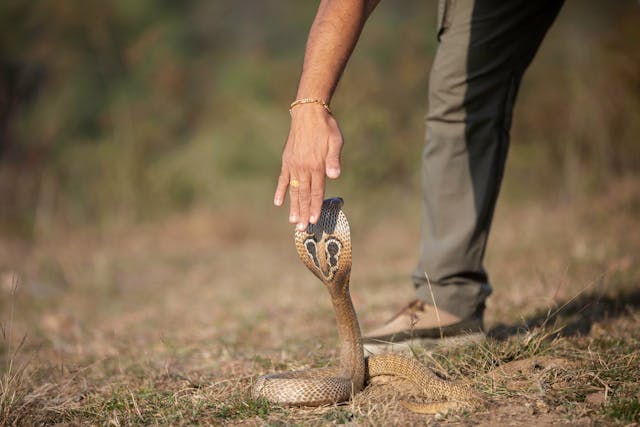India is home to a rich diversity of snake species, ranging from the deadly to the completely harmless. This incredible variety is spread across the country, from the dense forests to the arid deserts, each species adapted to its unique environment. Here’s a look at some of the most common snake species found in India and a guide to distinguishing the venomous from the harmless.
1. Indian Cobra (Naja naja)
The Indian Cobra, also known as the spectacled cobra, is one of the most well-known venomous snakes in India. Recognized by the distinct hood pattern, it can be found throughout the country. Its venom is highly potent, affecting the nervous system, and can be fatal if not treated promptly.
Venomous: Yes.
2. Russell’s Viper (Daboia russelii)
Russell’s Viper is another highly venomous snake commonly found in India. It is distinguished by its robust body, flat triangular head, and distinctive chain-like pattern on its body. This species is responsible for a significant number of snakebite incidents in India.
Venomous: Yes
3. Common Krait (Bungarus caeruleus)
The Common Krait is a slender, nocturnal snake that is highly venomous. It has a shiny black or bluish-black body with thin white bands. Its venom is neurotoxic, causing paralysis and potentially leading to death if not treated quickly.
Venomous: Yes
4. Indian Rock Python (Python molurus)
The Indian Rock Python is a non-venomous snake that can grow to impressive lengths. It is often found in forests and grasslands. Despite its size, it is harmless to humans and primarily feeds on small mammals and birds.
Venomous: No
5. Rat Snake (Ptyas mucosa)
The Rat Snake, also known as the dhaman, is a common non-venomous snake in India. It is often found near human habitats, feeding on rodents, which makes it beneficial to farmers. Despite its large size and sometimes aggressive behavior when threatened, it is completely harmless to humans.
Venomous: No
6. Green Vine Snake (Ahaetulla nasuta)
The Green Vine Snake is a mildly venomous but generally harmless snake, recognized by its bright green, slender body and pointed snout. Its venom is not harmful to humans, but it helps the snake subdue its prey, mainly small reptiles and frogs.
Venomous: Mildly (Harmless to humans)
Conclusion
While some of India’s snake species are highly venomous and pose a significant threat to humans, many are harmless and play a crucial role in the ecosystem. Understanding these differences is vital, not just for safety but also for appreciating the rich biodiversity that India offers. Always exercise caution and respect when encountering snakes in the wild, and remember that they are a vital part of our natural world.


Comments